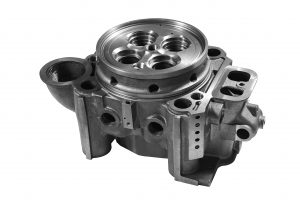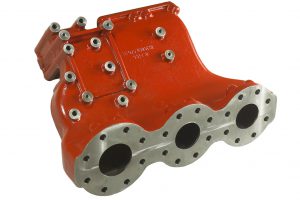Inside Casting & Machining Products (Part 2)
Part Two: Sand Casting
Sand casting is a manufacturing technique used to produce high performance metal components. This ancient casting process involves compacting sand around a 3D model or pattern to form a mold for use with a metal or alloy.
Sand casting is generally used to make structural metal components. Common parts produced using this process include:

- Engine blocks
- Cylinder heads
- Gear box housings
- Manifolds
- Transmission cases
- Connecting rods
- Combustors
Sand casting is compatible with several different types of metal alloys, providing users with some flexibility in the materials used to produce their products. Some common materials used in the sand casting process include ductile iron, grey iron, compacted graphite iron, nickel ductile iron, aluminum alloys, bronze, and steels.
Different Types of Sand Casting
There are several distinct forms of sand casting that manufacturers use to create metal components––each with its own unique characteristics.
Green Sand Casting
Green sand casting is the more common and more cost-effective form of sand casting. During the casting process, molten metal is poured into a mold made from sand that is bonded with water and clay. Green sand castings come with greater sizing restrictions, since the size of the casting is determined by the size of the mold boxes.
Resin Sand Casting
Resin sand casting is less commonly used than green sand casting because of its greater cost, but it affords much greater accuracy and complexity, as well as the ability to produce better surface finishes. Resin sand casting also offers greater flexibility in terms of the size and type of mold that it can create, since it’s not limited to the size of the mold boxes.
In comparison to green sand casting, resin sand casting yields stronger molds while accommodating a broad range of mold types, depending on the chemical reaction. In addition, it offers greater dimensional stability under molten metal pressure.
Sand Casting Process
Sand casting involves compacting sand around a 3D model or pattern to form a mold. The compacted mold is later split apart so that the interior pattern can be removed. The mold is then seamed together again, and molten metal is poured into the resulting cavity. Once the metal cools and solidifies, the surrounding sand is removed, and the newly casted part is unveiled.
This multi-step procedure involves the following actions:
- Producing the mold
Automated equipment is used to create the models around which the sand will be compacted to form the mold. - Melting and pouring
The metal or alloy to be used in the component is melted down and poured into the compacted sand mold. Once the molten metal cools and solidifies, it takes the form of the surrounding mold. - Cooling the metal
The molten must completely cool and harden before the surrounding sand mold can be opened. - Removing the cast part
The surrounding sand is removed once the metal has fully hardened to reveal the newly cast component. - Trimming the component
Any excess material is trimmed to ensure that the component takes the desired finish and shape. - Finishing the metal
Customers can incorporate additional treatments and processes to add special features or looks to their newly cast metal component to make it ready for assembly.
Advantages of Sand Casting
Sand casting in general offers numerous advantages over other casting processes. With minimal restrictions on the shape, size, and materials used in manufacturing, it can be used to create specialized prototypes and mass-produced components alike. Its versatility also extends to the number of parts it can produce at one time, since it’s suited to both low- and high-volume production runs. Because of its lower production costs, it’s much more cost-effective than other casting processes, as well.
Since 1998, Impro as provided high-precision, high-quality casted metal components for customers across industries. Our talented team of experts has extensive experience with a variety of casting processes––including sand casting––ensuring that we can provide any client with accurate, reliable, and consistent casted parts for use in a wide range of applications. Regardless of your needs, we’re here to supply you with a durable and efficient solution to your operational challenges.
To learn more about sand casting, or our other casting processes, download our eBook, Comparing Casting Processes today!
This is part two of a blog series. Check out part one and part three.

